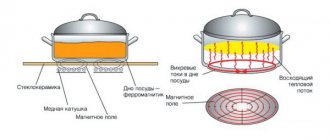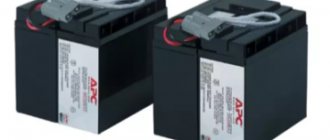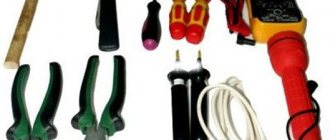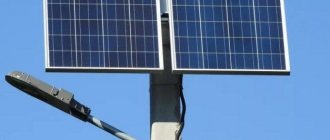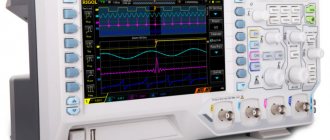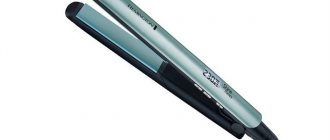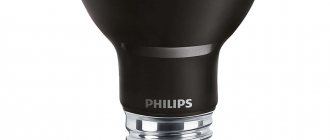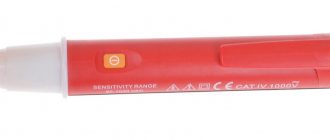It is impossible to imagine a modern apartment or house without a kitchen stove. However, when choosing the main assistant in cooking, it is not so easy to figure out which one is right for you.
In this article we will take a closer look at the pros and cons of induction hobs and the most important questions: how much electricity does an induction cooker consume, how does it work, how safe and convenient is it.
Ease of use
Both types of appliances are much more convenient than gas stoves, but they work differently.
The electrical panel first becomes hot itself, and then heats the dishes: this happens thanks to the thermal energy transmitted by the conductor. For cooking, you can use dishes made of a variety of materials, but always with a flat and thick bottom, the diameter of which must match the size of the burner (this will help avoid heat loss). The induction surface heats the cookware and its contents, and the diameter of the bottom does not matter - the main thing is that the material is magnetized. Cast iron and enameled pans with a completely flat bottom, as well as stainless steel containers, are suitable. Both types of panels, unlike gas panels, operate quite quietly. But if an electric stove is absolutely silent, then an induction stove makes specific sounds when the cooling fans are turned on. According to user reviews, you quickly get used to them and stop noticing them.
Electric and induction devices come in a variety of sizes, which allows them to be integrated into any kitchen set. The first type of product can have from two to five burners, and the second - from one to six. Control can be either touch or mechanical.
Differences between induction and electric cooker
Let's figure out how different the equipment is. The main difference between the devices is the principle of their operation. The electric stove first heats up, after which the dishes and food are heated. An induction cooker only heats the cookware, but remains cold.
An induction cooker only heats the cookware, but remains cold.
For an electric device, the type of cookware does not matter, but for an induction panel you will have to use special kitchen utensils. In this case, the second option is safer, since the surface remains completely cold. Also, the induction cooker heats up exactly as much as necessary so as not to overuse energy. This is a more economical solution with many advantages.
For an electric device, the type of cookware does not matter, but for an induction panel you will have to use special kitchen utensils.
About the induction cooker
The main functions of the equipment, heating and maintaining heat, are performed by a magnetic field. This increases the speed of cooking, makes the process economical, and provides a number of other advantages.
The dishes turn out juicier and almost do not burn. Therefore, such slabs are worth buying, even taking into account their higher price. Moreover, their operation can be made even more profitable.
Principle of operation
On electric or gas stoves, the burner heats up first, then the frying pan or pan on top heats up from it. The surface of induction technology remains cold, heating is provided by a magnetic field. Only the bottom of the cookware is heated, reducing heat loss and cooking time.
To boil 2 liters of liquid on an electric stove, 10 minutes are enough, on induction technology – only 6 minutes.
Testing the parameters of kitchen appliances showed that operation using magnetic field-induced currents increases the efficiency of the stove by up to 90%.
The same indicator for gas models is up to 65%, for electric models – no higher than 60%. In the increased power mode, the coefficient can be reduced to 80%, but the heating time is reduced.
Advantages and disadvantages
Food cooks faster on an induction cooker
The reasons for choosing induction cookers are:
- Safety. The low temperature of the panel protects against burns due to accidental touching and will not lead to fire. When the pan is removed from the stove, heating stops.
- Convenience. The edges of the burners do not become hot, allowing you to avoid burning drops of liquid or food particles that fall on the stove. When cooking, you can place a spoon on the surface.
- High speed. Dishes are prepared faster. When changing mode, the stove reacts instantly, unlike its electric counterparts.
- Economical. There is no heating of the burners - energy consumption is reduced. Depending on the frequency of use and the dishes being prepared, electricity consumption is 2-4 times less than that of an electric stove.
- Comfortable conditions in the kitchen. Energy is not wasted on heating the air. The room becomes less stuffy than with a gas or electric stove.
The list of features includes several disadvantages. When the panel operates, a low hum occurs that can cause discomfort.
The cookware should only be special, and the surface of the stove can be easily damaged or scratched. When planning to connect a hob with a power greater than 3.5 kW, you should focus on the quality of the wiring.
Comparison of power of different types of stoves
The power ratings of a gas stove are higher than those of other options. Its burners produce from 1 to 3-4 kilowatts. However, this does not provide gas with serious advantages. When converted from kW to rubles, the operating costs of induction equipment are similar.
The performance of a conventional electrical appliance reaches 5.5 kW. Induction models consume about 7 kW. The Power Boost function can increase the parameter up to 10 kW.
However, an electric stove will take 2-4 times longer to heat up. Therefore, with equal or even lower productivity, energy consumption is higher.
This becomes especially noticeable when comparing monthly consumption, which reaches 300-500 kW for electrical devices.
By comparing the performance of different models, conclusions can be drawn. Gas technology remains the most profitable and powerful.
But the savings are small. Moreover, induction models benefit in terms of safety, speed, and ease of use. Electric stoves with lower productivity are considered the most inefficient.
How much electricity is consumed per month
Calculating energy consumption, which all owners of houses and apartments have to pay once a month, becomes significantly more complicated if they have an electric stove. It is almost impossible to separately calculate exactly how much an induction hob will spend. But there are average standards that determine this figure at 1.3 kW/hour when all four burners are operating at a rated power of 3.5 kW. Daily use of cooking equipment for a total volume of at least 2 hours will require payment of 2.6 kW per day. About 78 kW will be consumed per month.
But there is another important point: these calculations can be called averaged. In fact, the calculation is carried out separately for each burner, since they are almost never made the same size. When operating a burner with a rated power of 1 kW for 2 hours at full heating, 2 kW will be consumed. But if heat intensity control is used, the final consumption will be less.
Hob selection
In addition to what power of an induction cooker is optimal, there is a list of other criteria that must be followed when choosing a hob
When purchasing a stove, it is important to initially decide for what purpose it will be used.
If you want to use a stove in public places (for example, in a restaurant), then it is best to give preference to equipment with a large working surface and high operating power. If the stove will be used in domestic conditions, then you can choose small models with an average level of performance.
In addition, when choosing, you should consider:
- type of panel selected: built-in or independent induction cooker;
- material from which the stove is made: glass ceramics, enamel or stainless steel;
- type of heating element;
- is there an oven included?
- the presence of heating sensors and a control system for smooth adjustment of burner performance.
The choice is also influenced by the cost of the stove. The price of hobs varies depending on the model configuration. The most expensive are panels with additional heating sensors for the burners, on which automatic smooth adjustment of the power of the induction cooker depends. If there is no need for sensors, then you can choose cheaper models that do not differ in quality from their expensive counterparts.
Design and principle of operation
To understand how much electricity an induction cooker consumes, you need to understand its structure and operating principles. Due to the special heating method, the device gained popularity in the market in a fairly short time. The heating process occurs by transmitting magnetic pulses generated by an electromagnetic field. It, in turn, arises through the passage of electric current.
To understand how much electricity an induction cooker consumes, you need to understand its structure and operating principles.
Traditionally, the heating surface of such a device consists of the following structural elements:
- control panels;
- main part (body);
- power plants;
- temperature sensor.
The peculiarity of this design is that the heating pulse is directed. This means that energy is not dissipated, but only heats the food in the pan. The surrounding objects remain cold.
Additional Information. This is a great option if you have a small child. Now he will not get burned by accident if he touches the surface of the stove. You no longer need to keep dangerous matches in your house.
Note! If you use an induction cooker, you will have to purchase new cookware. They must have the required magnetic penetration coefficient. The best option is ferromagnetic products.
Another innovative solution is that there is no need to install a heating coil. This approach reduced the amount of energy and increased system reliability.
Another innovative solution is that there is no need to install a heating coil.
The tile is a cooking surface in the form of a transformer. The induction coil is located immediately below it. The second element for the operation of the electromagnetic field will be the dishes that you place on the surface.
The second element for the operation of the electromagnetic field will be the dishes that you place on the surface.
The device is constantly connected to the network. Heating occurs only at the moment when the corresponding container is placed on the burner. The principle of operation is as follows - alternating current passes through the coil and forms an electromagnetic field, which is transmitted to the bottom of the dish. Under its influence, the surface begins to heat up to the desired temperature. Food is cooked using heat currents that are spread by a heating magnetic field.
Food is cooked using heat currents that are spread by a heating magnetic field.
This method is characterized by low energy consumption. All heat is directed exclusively to the target container, allowing you to cook food much faster. At the same time, the power of induction cookers in kW is 3.5, which is much lower than that of conventional gas or electric appliances.
All heat is directed exclusively to the target container, allowing you to cook food much faster.
To control the entire cooking process, there is a control panel on top. With its help, the presence of capacity on the surface is determined, and the optimal power level is established based on the obtained characteristics.
To control the entire cooking process, there is a control panel on top.
Harmful radiation
Many housewives are afraid of the harmful electromagnetic radiation that all induction cookers have.
There is definitely radiation. However, it does not have a harmful effect on you, even if you put your head to the stove itself. You are not a cyborg with an iron brain to create eddy currents.
With normal use of the panel, when you cook food at a distance of 20-30cm from its surface, no negative effects occur either.
At a distance of up to 10 cm from the stove, the intensity of the electromagnetic field is about 140 Volts/meter. At a distance of up to 0.5 m it drops to 15 V/m. Here are the acceptable values for this indicator:
Some people mistakenly compare induction cookers to a microwave. But there are completely different frequencies. The microwave contains microwaves (ultra high frequencies), which cause resonance of water molecules. Their friction causes the water to boil. And our body, including the brain, consists of water.
However, we still use microwave ovens. Induction cookers are much safer in this regard.
Measurements were even taken and it turned out that the electric magnetic field near the stove is tens of times less than near an electric hair dryer, which you regularly dry your hair with and bring directly to your head.
However, sick people who wear special pacemakers need to be very careful.
The electromagnetic field of the stove, under certain conditions, is quite capable of damaging such a device. Therefore, in order not to take risks, the instructions usually state that people with similar diseases should be at least 30 cm away from the surface of the panel.
But this is standard reinsurance for manufacturers of such equipment. Some instructions for microwave ovens in the USA even indicate that wet cats should not be dried in them.
Also, do not forget about bank cards and magnetic passes. They should not be brought too close to the stove during cooking, as they may become demagnetized.
How does an induction cooker work?
https://youtube.com/watch?v=jPvXzmyl4UM
Induction cookers are a relatively new type of kitchen appliance that is gaining popularity due to its safety and ease of use.
Although a tabletop induction cooker is more expensive than a gas or electric one, it has a number of advantages over them.
The energy of a magnetic field is used to heat the cookware. This means that it is not the cooking surface that heats up, but the bottom of the pan. The burner itself remains cold around the edges.
If you want to buy a tabletop induction cooker, you will also have to purchase special cookware.
The bottom must be made of ferromagnetic materials (cast iron or stainless steel). Other materials will not heat up. Without special cookware installed on the hob, the device will not turn on. The pot or pan should occupy at least 70% of the burner surface.
It is worth paying attention to the Booster operating mode. It allows you to transfer power from one burner to another
This is convenient if you need to quickly cook or heat something on an inactive burner.
Induction cookers are the pinnacle of technological progress today. The principle of a transformer is used here: one winding is under the glass, and the second winding is a pan.
The heat is released directly into the pan. If the pan is removed from the induction hob, heating will stop. This makes induction cookers more economical - there are no intermediate heat losses. Induction cookers are also safer to use as they generate less heat.
Induction cookers (surfaces) are:
- small-sized portable ones with one burner (tabletop);
- built into kitchen furniture;
- combined: some of the burners are induction, some work on heating elements.
An induction cooker heats metal cookware with eddy currents that create high-frequency magnetic fields with a frequency of 20-100 kHz.
Power can be adjusted in two ways:
- continuously;
- impulsively - turns on and off once every few seconds.
At maximum power, the stove operates at a frequency of 50-100 kHz, and when the power decreases, the frequency decreases. At a frequency of 20 kHz, the burner operates in intermittent heating mode.
A special feature of these stoves is the cold surface around the heating zones, which minimizes burns during the cooking process.
The stoves are equipped with different types of heating elements:
- spiral heaters - the spiral heats up quickly (in 15 seconds);
- tape heaters - made in the form of a tape, coiled in the form of a spring, like in a mechanical watch (heats up within 8 seconds);
- halogen heaters - a tube filled with halogen gas in which a heater is built. The current passing through the heater emits halogen gas, which heats the cookware. Heating occurs instantly after switching on. Operates at full power in 3 seconds;
- Induction heaters create a powerful high-frequency magnetic field that heats the bottom of the cookware.
Principle of operation
Instead of a heating element, inside an induction cooker there is an induction coil made of copper wire, which creates a magnetic field between the surface of the cooker and the cookware when an electric current ranging from 20 to 100 kHz is applied. The magnetic field, in turn, directs its vortex currents through the glass-ceramic surface of the cookware with a magnetic bottom, which in this case acts as a conductor with a closed loop. As a result of the movement of electrons, heat is released, which heats the container and its contents.
The undoubted advantages of a kitchen stove using the principle of electromagnetic induction are its elegance and decent functionality.
Electricity consumption
An induction hob burner consumes an average of 1.5 kW of electricity per hour. Water in a five-liter saucepan boils in 6 minutes. To cook pasta, you will need to boil water and cook for 10 minutes.
This is exactly the amount of electricity needed to cook pasta on an electromagnetic stove:
- 10 min. + 6 min. = 16 min.;
- 1.5 kW/h: 60 min. = 0.025 kW/min;
- 16 min. x 0.025 kW/min. = 0.4 kW.
The price per kW of electricity in the central region of Russia averages 4 rubles.
0.4 kW x 4 rub. = 1.6 rubles - this is the amount you will spend on preparing pasta.
It is quite difficult to calculate how much electricity a particular family will consume. However, using this formula, you can do it yourself. We will try to give an average value.
Let's say you cook 2 dishes 3 times a day, each for 15–20 minutes:
- 20 minutes. x 0.025 kW/min. = 0.5 kW;
- 0.5 kW x 2 x 3 = 3 kW (per day);
- 3 kW x 30 = 90 kW (per month);
- 90 kW x 4 rub. = 360 rub.
Electricity consumption
When determining how much electricity will be consumed by the hob, various factors are taken into account. The first is power consumption in kW. The second is the number of hours during the day or month that the stove is on.
Uneven usage makes it difficult to accurately measure this value. But there are average indicators for determining monthly consumption.
How much electricity is consumed per month
Energy consumption classes
Among the parameters by which a hob is selected, energy consumption is one of the main ones. When determining it, it is not the performance of individual burners that is taken into account, but the total electricity consumption per month. According to this indicator, an induction cooker is superior to other types of kitchen appliances.
Average standards for a model with a total productivity of 3.5 kW are 1.3 kW per hour. Turning on the equipment daily for 2 hours leads to a consumption of 2.6 kW per day. Consumption during the month is about 80 kW. For powerful 7-megawatt equipment, up to 160 kW is spent per month.
Consumption depends on three factors. The first is the performance of the burners. The second is frequency of use.
The third is the equipment energy consumption class. It is designated by Latin letters - from A to G. The best options are with class A+, A++ or A+++. Savings when using such cookers will increase by another 20-40%.
Energy Saving
Buying an induction cooker will save you money on cooking. But electricity costs can be further reduced.
After all, even the amount spent on paying for several tens of kilowatts may not be superfluous for the family budget. To reduce the numbers on your electricity bills, you should use the following recommendations:
- It is advisable to choose models with automatic switching off of the burner when the pan is lifted. This will reduce electricity consumption and also increase safety.
- To heat small dishes or brew coffee, use smaller burners. Although for some models the size of the zone can be adjusted automatically.
- It is recommended to heat a large frying pan or saucepan on the maximum size burner. This will reduce time, increasing the efficiency of using equipment.
- To cook in oval-shaped dishes, you should use two burners at once. Most induction models allow you to make paired heating zones.
For fast heating, a mode is used in which special heavy-duty circuits are turned on. But for normal cooking, it is enough to set the power regulator to about the middle.
When using a lid on a pot or frying pan, this capacity is enough to cook food. However, electricity consumption will drop by almost 2 times.
It is impossible to imagine a modern apartment or house without a kitchen stove. However, when choosing the main assistant in cooking, it is not so easy to figure out which one is right for you.
In this article we will take a closer look at the pros and cons of induction hobs and the most important questions: how much electricity does an induction cooker consume, how does it work, how safe and convenient is it.
Rated power of the electric stove and general equipment design
The electric stove model, on which induction burners are installed, has a new way of heating food, which allows you to heat or cook a dish in the shortest possible time. The peculiarity of these household electric stoves is that they have a magnetic field, which is maintained by high-frequency coils, transmitting an induction current to the surface of the cookware, which produces heating.
The hob of an electric stove, for example, Bosch, has:
- Temperature sensor;
- Body;
- Control panel;
- Power part.
For an induction cooker, it is best to purchase special cookware
Since the hob affects a certain point or, in other words, not the surface of the cookware placed on it, everything that surrounds this place remains completely cold. This is very useful for those who have small children at home or are faced with such a problem as burns on the surface of the burners.
The cookware is selected that has increased magnetic permeability and has a fixed value in resistivity. The best option would be dishes made from ferrimagnetic material, as it fully meets all requirements.
Operating principle and power consumption
Any of us understands how an electric or gas stove works. With induction everything is not so clear. This kitchen unit went on sale relatively recently, and there are still many household myths around it.
How does an induction cooker work?
The induction surface cooks using electromagnetic induction. This physical phenomenon allows metal utensils to be heated by eddy currents.
The hotplate only turns on if a suitable pan is placed on it. And turns off as soon as it becomes empty. Copper coils are located under the electronically controlled glass-ceramic panel.
Energy consumption
When buying equipment for your home, the first thing you should think about is saving energy. The energy consumption of induction and electric cookers is approximately the same. The average value is about 7 kilowatts per hour. This figure may vary depending on the number of burners and their size. However, an induction panel heats the same volume of water five times faster than a heating element electric stove of the same power.
In addition, the induction hob stops heating as soon as you remove the dishes and does not heat itself or the air around it. Having assessed these factors, we can say that the induction model is much more economical than the electric one.
Possibility of power adjustment
The power of the induction cooker is adjusted by sequential switching on and off. During cooking, the power can be changed. Also in some models it is possible to set the required heating temperature on the control panel.
Types of burners and their performance parameters
Manufacturers offer customers induction hobs with burners of different diameters:
- Medium electric burners are used to stew meat and vegetables for the whole family.
- The smallest ones (from 0.4 to 1 kW) are designed for stewing small amounts of meat, making porridge, and coffee.
- Fast heating have maximum power (1.5-3 kW). They can be called “HiLight”, “SuperQuick”, “Hight-Ligh” or “express”.
There are models with dual or dual-circuit electric burners. They allow you to expand the heating zone so that you can cook food in oblong-shaped dishes. You can quickly cook food on an induction glass-ceramic hob with maximum power, but you must take into account the condition of the wiring. If the electrical network is old and has not been changed for a long time, then since such a device consumes a lot of energy, when connected, there is a possibility of knocking out the plugs in the panel or igniting the electrical wiring.
Control Panel
Modern induction panels look more like elements of spaceships than household appliances. The birth of such an association is greatly facilitated by the appearance of the control panel.
Here you can see many touch buttons - separately for each power level, and touch sliders, which can be not only linear, but also circular, and a TwistPad magnetic switch in the form of a rotary removable disk. In some models, each burner is equipped with an individual set of touch buttons or a slider.
Magnetic switch in the form of a rotary removable disk.
Touch buttons.
Touch slider.
Information about the operation of the device may also be displayed differently. Many models have a circular display for each burner, and the numbers that you can see inside this glowing outline correspond to the selected settings.
With their help, you can easily assess the situation on the stove: the current power level in a particular heating zone, timer readings, etc. But liquid crystal touch TFT displays are still a rare phenomenon in the world of induction hobs. Today they can only be seen on some premium devices.
Manufacturers are constantly working to improve the control unit, and all in order to simplify your “communication” with the induction panel as much as possible. There are many ways to control equipment; you just have to figure out which one will be most convenient for you.
Stove power
So, let's move on to the question, how many kilowatts does an induction hob consume? Let's start with the fact that manufacturers today offer different models with different power characteristics. There are low-power models - up to 3.5 kW, and there are quite powerful ones - up to 7.0 kW. Let's look at the second option for clarity.
This induction hob has four burners:
- Two small burners with a heating diameter of 160 mm. The power of each is 1.5 kW.
- The middle burner has a diameter of 180 mm. Its power is 2.0 kW.
- And the larger one with a diameter of 210 mm also has a power of 2.0 kW.
If we compare conventional electric hobs with this induction hob, then in terms of power characteristics they will be the same. That is, it seems impossible to say that induction models are more economical than conventional electric ones. But there are savings, and it’s not for nothing that manufacturers talk about it all the time. Where is she?
Let's return to induction currents, which directly affect the dishes. It is the high efficiency of the device, it is the magnetic field and induction currents that create the conditions under which water boils in dishes two to three times faster. The same goes for heating food. That is, cooking on induction panels occurs faster, which means less electricity is spent on them. An experiment was carried out in which a kettle with 1.5 liters of water was installed on two different stoves. So, on the electrical panel where the heating elements are installed, the kettle boiled after 14 minutes. On induction this happened after 5.5 minutes. That's all the savings for you.
Induction cookers - saving electricity
That is, electricity consumption in this case does not depend on the power of the burners, it directly depends on the heating time of the dishes. In addition, I would like to add that you can save money in hobs in another way. And many housewives do not know or have no idea about this. But it is precisely some chef’s tricks that make it possible to save a lot of money. For example, after boiling water, you can reduce the heating intensity. This is very easy to do on hobs. There is no need to twist anything, everything is done by pressing your finger.
- Maximum heating is performed at position “9”. But they are rarely used.
- Intensity is most often used in positions 6-8.
- Heat food for 3-4.
That is, after heating a bowl of water to a boil, you can cover the same pan with a lid and reduce the power supply to position “3”. The same soup at this intensity of operation of the stove will cook for the same amount of time as at maximum heat without a lid.
And one more point regarding the very convenient option of an induction hob. If you remove the cookware from the burner, the power supply is immediately turned off. That is, there is no need to manually turn off the device, the automation will do it for you. Where are the savings? It consists in the fact that many housewives first move the dishes away and then only turn off the stove. The habit is not the best, but many women suffer from it (this is the mentality).
That's why manufacturers took care of automatic shutdown. It would seem like just seconds. But if you add it all up over a month, you get a decent amount. After all, engineers who work at manufacturing plants try to reduce energy consumption to a minimum, based on the capabilities of modern technology. Because this indicator is the most important for many consumers. After all, no one wants to overpay.
Testing the electricity consumption of classic and induction stoves
The main advantages of induction hobs include the following:
- heating food;
- wide range of activities;
- the possibility of accidentally getting a burn and, in principle, serious injury is excluded;
- ease and speed of use;
- highest efficiency (about 90%);
- automatic shutdown when removing dishes;
- there is no dependence of power on network voltage;
- savings because it consumes less electricity per month;
- amazing performance.
However, in addition to the positive characteristics, there are also not very pleasant ones, which directly come from the mechanism of operation and functioning of the stove:
- High demands of this type of electrical panels on the utensils used (as mentioned above, not all utensils are suitable for this type of surface. Do you want universal advice? The lighter and thinner your pan, the higher the likelihood that it will not be suitable for use).
- It is difficult to carry out repair work; it is impossible to do without a qualified specialist in this field.
- The influence of radiation on other types of household and technical appliances in the kitchen (the danger of interaction between an induction panel and an oven, for example, or a refrigerator).
Review of popular induction hobs
Currently, induction hobs are produced by all well-known manufacturers of kitchen equipment (Siemens, Electrolux, Whirlpool, etc.). The product range includes not only tabletop and built-in hobs, but also complete induction cookers, the power of which depends on the number of burners. Based on reviews from experts and consumers, the models that make up the TOP 5 ratings of the most popular induction hobs were identified.
Siemens
Siemens EH875SC11E is a large hob equipped with five burners of different power. Two of them have an oval shape and are able to independently adjust to the dimensions of the bottom of the dish. This reliable and powerful surface features responsive touch controls and is equipped with an auto-off timer, a control lock and a residual burner temperature sensor. There is also a zone in which dishes can be kept warm for a long time.
Induction cooker Siemens EH875SC11E
Induction cooker Siemens EH875SC11E on Yandex Market
Bosch
Bosch PIN675N14E is an original hob equipped with 4 burners. In this case, two of them can be combined and work as one heating zone (Flexinduction). In addition, there is a PowerBoost function that can be activated for each individual burner. Its essence lies in the ability to increase the heating power of one burner by 50% at the expense of the adjacent one. Electronic control of the panel provides 17-step power adjustment and digital indication of the degree of heating.
Induction surface Bosch PIN675N14E
Induction surface Bosch PIN675N14E on Yandex Market
Zanussi
Zanussi ZEI 5680FB is a budget model that is equipped with 4 burners of different sizes. It features simple controls and a sleek design. The panel provides automatic shutdown in case of liquid spillage and control blocking if necessary. All users note its high productivity and operational reliability.
Induction surface Zanussi ZEI 5680FB
Induction surface Zanussi ZEI 5680FB on Yandex Market
Maunfeld
Maunfeld MV159.4HZ.2BT-BK is one of the best induction hobs in the price/quality category. It is equipped with 4 burners, each of which has a power of 1.4 kW. Moreover, two of them have a Booster option, which allows you to increase the power of the burner to 1.8 kW (fast boiling mode). The panel is distinguished by a wide range of functions that provide indication of residual heat of the burners, automatic shutdown when liquid is spilled, child protection, etc.
Induction surface Maunfeld MV159.4HZ.2BT-BK
Induction surface Maunfeld MV159.4HZ.2BT-BK on Yandex Market
Hansa
It is necessary to note the full-fledged, free-standing electric stove Hansa FCIW53800. Structurally, it is a familiar hob with induction burners, combined with an electric oven. Electronic control of the stove ensures fast and even heating, automatic switching on and off of burners in accordance with previously set times, and much more. The oven is equipped with a hot air fan and has a “Grill” function. In addition, the model is equipped with two independent timers with sound indication - separately for the oven and hob.
Induction cooker Hansa FCIW53800
Induction cooker Hansa FCIW53800 on Yandex Market
The best 2-burner induction hobs
The rating contains the best models of induction cookers with 2 burners.
Weissgauff HI 32
A mid-price domino stove with large burners (16 cm and 18 cm, while the standard size of domino burners is usually smaller: 14 cm and 16 cm), fast heating and good functionality. It is worth noting that this is one of the best models of 2022.
Main characteristics:
- dimensions (HxWxD), cm - 5.8x29x58;
- power, kW - 3.5;
- surface material - glass ceramics;
- switches are touch sensitive, heating adjustment is smooth;
- burner timer - yes;
- protection - panel locking, protective shutdown, residual heat indicator.
pros
- low price;
- good quality;
- timer for each burner and one common timer;
- fast heating;
- large size burners.
Minuses
- there is no interval heating, that is, “simmering” will not work - the food is boiling;
- “intermittent” heating;
- slight noise during operation;
- there is no metal frame along the contour;
- inconvenient location of the burners: the large one is closer, the small one is farther away.
MAUNFELD EVI 292-BK
A small induction domino cooker with standard functionality, fast heating, Booster mode, medium-sized burners and a stylish appearance.
Main characteristics:
- dimensions (WxD), cm - 28.8x52;
- power, kW - 3.5;
- surface material - glass ceramics;
- switches - touch, push-button control;
- burner timer - yes;
- protection - panel locking, protective shutdown, residual heat indicator.
pros
- comfortable, beautiful, inexpensive;
- quality;
- good functionality;
- ease of care.
Minuses
- The fan is very noisy;
- noise when both burners operate simultaneously;
- short cable, no plug;
- The timer only works when the burners are turned off; you cannot set it for a while without then turning it off;
- does not turn off when food is spilled;
- a large heating “step”: so, at 4, it is not yet fried and boils very weakly, and at 5, it is already burning and boiling over the top.
Weissgauff HIF 32
Another “domino” stove from the manufacturer Weissgauff is equipped with large burners of the same size (18 cm), but of different power (1.5 kW and 2 kW). This is one of the highest quality models for 2020.
Main characteristics:
- dimensions (HxWxD), cm - 5.8x29x52;
- power, kW - 3.5;
- surface material - glass ceramics;
- switches are touch sensitive, heating adjustment is smooth;
- burner timer - yes;
- protection - panel locking, protective shutdown, residual heat indicator.
pros
- low price;
- timer for each burner and one common timer;
- fast heating, booster;
- cable with plug.
Minuses
- the minimum power is too high - at “1” the water is already boiling;
- “intermittent” heating;
- burners are located too close to each other;
- sensors are too sensitive.
If a low heating function is required, then from this manufacturer you should give preference to models 2022 and younger (without the letter “b” in the name) - these models implement constant rather than pulsed heating, which allows you to evenly maintain the temperature at small heating levels.
Electrolux EHH 93320 NK
A more powerful 2-burner stove from a well-known manufacturer with 18 cm burners, equipped with a “Stop&Go” function (short-term pause) and sensitive sensors.
Main characteristics:
- dimensions (WxD), cm - 29x52;
- power, kW - 3.6;
- surface material - glass ceramics;
- switches are touch sensitive, heating adjustment is smooth;
- burner timer - yes;
- protection - short-term pause, panel blocking, protective shutdown, residual heat indicator.
D
pros
- does not make noise during operation;
- separate buttons and own timer for each burner;
- convenient “Pause” button;
- nice design;
- intuitive controls.
Minuses
- The surface is glossy, fingerprints remain;
- two large pots or pans are no longer included;
- The timer continues to ring even after the burner is turned off and turns off only after pressing.
Zigmund & Shtain CIS 030.30 CIS 030.30 BX
The two-burner domino induction surface is equipped with 9 power adjustment levels and a “Booster” function.
Main characteristics:
- dimensions (WxD), cm - 29x50;
- power, kW - 3.5;
- surface material - glass ceramics;
- switches - touch, push-button control type;
- burner timer - yes;
- protection - panel locking, protective shutdown, residual heat indicator.
pros
- functional, easy to use;
- presence of a timer on each burner;
- accelerated heating;
- nice design;
- ease of care.
Minuses
- heating is pulsed, when selecting mode “8” and higher, it makes a loud noise;
- high price.
How does an induction cooker work and how does it work?
An induction hob consists of a housing, a temperature sensor, a control panel and a power section.
The process is controlled by a control panel. It is she who determines whether the dishes are placed on it or not.
By the way, not all utensils are suitable for such a device: you need utensils with high ferromagnetic properties, that is, metal utensils with the ability to magnetize. As a rule, cookware for induction is specially marked with the word “Induction” in translation “induction”, or with a zigzag icon. But if the manufacturer is no-name, and there is no marking, you just need to bring a magnet to the bottom of the dish: if it sticks, everything is in order, the dish will fit.
There is also an adapter for induction cookers - it allows you to cook food in aluminum, ceramic and glass cookware.
The technical data sheet of the device states that the size of the cookware should not be half the size of the burner, otherwise electromagnetic waves can affect everything nearby - electrical appliances or people.
The thickness of the bottom of the cookware for an induction cooker must be at least 2 mm
The principle of the device is radically different from the design of a classic electric stove.
The stove operates on the principle of a transformer - under the glass-ceramic panel there is an induction coil as the primary winding, and a flow of inductive energy passes through it. Its frequency is approximately 20-60 kHz. The dishes that are placed on the surface act as a secondary transformer winding. This creates a high-frequency electromagnetic field that produces heat and transfers it to the cookware and its contents. Objects located near the hob, as well as the burner itself, do not heat up.
Algorithm of operation of an induction cooker
Induction panels can vary in the following parameters:
- by its performance;
- by the number of circuits;
- by the presence or absence of an oven;
- according to the size of the cooking surface;
- by the presence of a heating temperature control control system.
What is the difference between an induction cooker and a hob?
The electrical panel is heated by the flow of current. That is, first the panel heats up itself and only then the dishes. Induction surfaces produce heating using a magnetic field originating from a special coil located under a glass-ceramic coating and immediately heats the bottom of the container.
Interesting materials:
How to call the DPR on a landline from Ukraine? How to call Yerevan from a mobile phone? How to call Gorgaz from a cell phone? How to call Irkutsk from a mobile phone? How to call Kyiv by landline? How to call London from a landline? How to call Mogilev from Russia from a landline? How to call Moldova on a mobile phone? How to call Moscow from a landline phone? How to call Samara on a cell phone?
What characteristics are important?
When choosing electric stoves, the most important thing to consider is the required number of burners for the family. You should not chase a large number of burners. For an average family of up to five people, it is usually sufficient to have a stove with one double burner and two separate burners of different sizes and power. Individual heating of the circuit allows you to control energy consumption. For a family of three, it will be enough to have a stove with just two burners of different power.
Before choosing a hob based on power, it is worth considering that options may increase the energy consumption of the electrical appliance. Built-in touch screen or temperature control from the remote control, other functionality also consumes electric current. The level of the brand also matters - the largest companies have their own ways of reducing energy consumption. For example, the use of boosters or even distribution of power across all burners.
The durability of ceramics and protection from electric shock also mean a lot. For cheap Chinese “no-name” stoves, the service life of the cooking surfaces is usually not comparable with the cost of purchasing them.
How to decide on the number of burners, their shape and size
Different models of induction cookers can be equipped with a different number of burners, and the latter can be of different sizes and shapes. How to decide on these parameters?
Required number of burners
The number of burners for different induction panels can vary from 2 to 6. However, there are also models with one burner - compact portable stoves or built-in modules of the “domino” system.
A stove with how many burners should you prefer? This depends primarily on the size of your family, which means how often and how much you will cook and fry. If you have a small family and/or prefer to eat out, there is no point in spending money on a full-size appliance. The more heating zones your induction hob has, the more dishes you can cook at once.
Induction panels with two heating zones are usually purchased by bachelors and childless couples. Stoves with 2-3 burners are preferred by owners of small kitchens: on the one hand, this is quite enough to accommodate everything you need, on the other hand, it will not clutter up the already cramped space.
Panel with two burners.
Models with 4 heating zones are the most common and popular option: on such a hob you can simultaneously cook the first and second courses and boil the kettle.
Panel with four burners.
And finally, if you have a large family or you simply love to cook and devote all your free time to this hobby, purchase a hob with 5-6 heating zones. However, be prepared for the fact that such full-size appliances will take up quite a lot of space in your kitchen.
Panel with six burners.
As for the arrangement of burners on the hob, manufacturers have long moved away from the standards and, in addition to the usual square placement, offer other, most unusual options. Today you can find models in which the heating zones are located in one row, or in a triangle, or in a semicircle - it all depends on the shape and size of the stove.
A panel with a non-standard arrangement of burners.
When choosing an induction hob with a particular burner arrangement, try to evaluate how convenient it will be for you to use this appliance. You should be able to easily reach the cookware no matter which burner it is on. In addition, pots and pans placed on adjacent heating zones should not interfere with each other.
Dimensions and shape of burners
An equally important criterion for choosing an induction hob is the size of the burners. According to this parameter, they should approximately correspond to the size of the dishes available in your home.
If the bottom of the pan does not cover 70% of the heating zone, the stove will not turn on.
Typically, the diameter of the burners on induction panels ranges from 14 to 21 cm. It is more convenient when the stove has burners of different sizes, respectively designed for different containers. The most “advanced” (and therefore expensive) models of induction panels are capable of automatically expanding or narrowing the heating zone, adjusting it to the size of the bottom of the cookware placed on the hob.
The boundaries of the heating zone are usually outlined on the glass-ceramic surface. Moreover, this is not always the usual circle; you can often see squares, hexagons or rhombuses. In this case, the shape is more of a purely decorative function - all these burners are the same in operation.
The designation of heating zones on the hob may differ for different models. For some, this means highlighting the boundaries of the burner with color, for others it is just a cross marking the center of the zone, while others even have a plain surface. On expensive panels, sometimes along the contours of the burners you can even see displays that reflect the power of the heating zone at the moment and the time remaining until the end of the process.
Options for designating heating zones
How to choose an economical stove
Based on the information above, when choosing an induction cooker, you should start from the required number of burners. In this case, there is no need to take the stove “in reserve”. On average, you should focus on the following numbers.
- A standard family of 3-4 people will need a 4-burner surface. But a more reasonable solution would be a 3-burner panel, where one heating element will be adaptive, and the other two will differ in power and size.
- For a couple without children or one person living alone, it is quite possible to get by with a surface for 2 burners. It is better if they are of different sizes.
The second important point when choosing energy-saving tiles is their functionality. It is worth remembering that each option used in the device increases energy consumption. Therefore, before purchasing, you should consider whether you need a touch screen, PowerBoost express heating and other additional functions.
When choosing, you should give preference to proven, renowned manufacturers. As a rule, such companies use energy-saving modes in their developments. In addition, the protection against electric shock and the quality of the materials used in such tiles will be much higher than that of cheap “no-name” brands.
Which one is better to choose?
The induction hob does not require extensive maintenance; it gets dirty less and is easier to clean. But the cost is many times more expensive than electric, and you need special cookware with a thick bottom. But the cooking time will be reduced by 2 times due to high efficiency, and the price will pay off within 1 year due to the saved electricity. In terms of safety, glass-ceramic is much inferior to induction.
Only people who have pacemakers are at risk. Induction does not in any way affect the quality of the food being prepared.
When choosing a stove, you should also pay attention to the manufacturer and the class of electricity consumed. Induction cookers are becoming increasingly popular in Russian markets, as they have fewer disadvantages compared to their competitors. But the choice is yours!
All installation work must be performed only by a qualified technician.
Induction cooker power
Induction cookers are quite expensive due to the more complex principles of their implementation, as well as high power. However, it is this type of equipment that allows you to reduce energy consumption to humane figures on the meter due to the following nuances:
- almost instant heating;
- heating an empty (without dishes) burner does not happen in principle;
- energy losses due to heat transfer are minimized.
The use of a completely different principle than in a traditional stove made it possible to achieve such results. The stove does not heat up; heat appears in the bottom of the pan. There is no process of heat transfer from the stove to the pan (more precisely, there is when the heated pan gives off a little heat to the surface on which it stands). The heating rate thus increases. There is no energy loss into the air.
Working principle of an induction cooker
The rated power of induction cookers is quite high, but if you follow certain rules, you can cook on it more economically than on other types of cookers. Thus, the maximum power of the device can reach 7 kW. But this figure occurs when all burners are operating simultaneously at the maximum level. This doesn't happen often in everyday life. Usually the housewife cooks at a power of 6-8 out of 9, and with some technologies (heating, stewing) even at a level of 3-5. As a result, the actual total energy consumption is not as scary as the theoretical capabilities of the stove.
The speed of cooking with induction is also higher, since the cookware reaches the “working” temperature faster. The dish cooks faster, the stove runs for less time and, as a result, consumes less electricity.
The high efficiency of the induction cooker allows you to save energy
Induction hobs have the following power:
- a “pancake” with a diameter of 16 cm produces 1.5 kW at peak;
- the middle 18 cm burner can operate with a power of up to 2 kW;
- a large burner with a diameter of 23 cm can consume approximately 2 kW in operation.
The total maximum power of the stove is just 7 kW. It is this figure that should be taken as the calculated value when designing a kitchen electrical circuit, despite the fact that the actual power will usually be lower.
What determines energy consumption?
The amount of consumption of an induction cooker during use largely depends on how many burners are turned on. It is worth noting that the greater the power consumption, the greater the effect on surface performance. With relatively high power consumption, cooking takes less time and effort compared to electric and gas stoves.
When purchasing this type of electrical device, make sure of the quality of the electrical wiring in the house in order to protect both yourself and the device from undesirable consequences.
